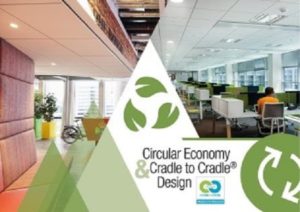 A powerful CPD presentation on the role of Cradle to Cradle design in the built environment has been approved by RIBA for Armstrong Ceiling Solutions.
A powerful CPD presentation on the role of Cradle to Cradle design in the built environment has been approved by RIBA for Armstrong Ceiling Solutions.
“The circular economy and Cradle to Cradle design,” presentation is designed to help architects understand the concept of a circular economy and the industry drivers and business case for adopting circular design principles. It also helps them evaluate the performance characteristics of ceiling systems designed for circularity.
The CPD pulls no punches when it explains how “the making of things is destructive” and how the construction industry has to change from its traditional “take, make, dispose” process to designing buildings for disassembly and re-use.
It explains the definitions, principles and benefits of a circular economy as well as those benefits specific to the built environment.
The Cradle to Cradle design concept is built around five principles:
1. Circular design which eliminates the concept of “waste”, with intentional nutrient cycles to retain the full value of the nutrient.
2. Material health in designing products that are safe for humans and the environment, from production to use to re-use.
3. Design for disassembly and recovery through buildings which are designed intentionally for material recovery, value retention and meaningful next use.
4. Value chain collaboration which innovates and accelerates circular solutions. This requires early and frequent engagement of all stakeholders, from the supply chain and material manufacturers, through architectural and interior designers, to owners and developers, and banks and financiers.
5. Quantifying value by creating and retaining value over the life cycle of a product or building. This is enabled by the identification, optimisation, verification and tracking of materials thoughtfully designed and assembled for whole building circularity.
Guidance is also given in the CPD on how design principles can be applied in practice but it points out that although a reasonably high level of understanding of the generic principles of designing for deconstruction exists, there seems little commercial appetite for doing it.
However, the manufacturing sector has responded by adopting the Cradle to Cradle standard as product design and innovation leads the process, and currently 185 products from the built environment sector are certified. The in-use phase is under increasing focus as building owners, operators and occupants want to know the impact and benefit of the product when installed and also how value can be retained throughout its lifetime.
Armstrong’s new CPD also explains how Cradle to Cradle accreditation has been designed to be flexible, with five different levels of certification (basic to platinum) acknowledging that products are not perfect from a Cradle to Cradle perspective but encouraging continuous improvement in the five criteria of material health and re-utilisation, renewable energy and water stewardship, and social fairness.
It also quantifies the benefits of the mineral ceiling tile recycling programme that Armstrong pioneered in the UK in 2003 and advises on tools useful for tracking the value of materials.
The presentation, which gives architects a one-hour CPD credit, covers the new CPD core curriculum subjects of design, construction and technology to a general awareness knowledge level.

